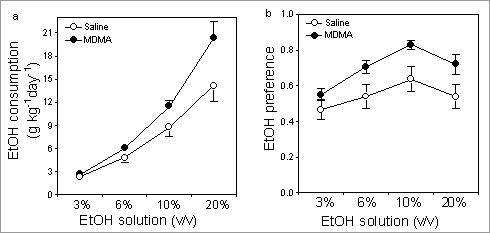Print version
Search Pub Med
Evidence that a neurotoxic dose of MDMA increases ethanol preference and consumption in mice
3,4-Methylenedioxymethamphetamine (MDMA, ‘ecstasy’) induces a long-term reduction in dopamine (DA, Colado et al., 2001) content and density of DA transporters (DAT) in mouse striatum. Since knock-out mice with deletions of genes for DAT show higher ethanol (EtOH) consumption than the wild type (Hall et al., 2003) it appears that the dopaminergic system can modulate EtOH consumption. We have now examined EtOH consumption and preference in MDMA-lesioned mice. Adult male C57BL/6J mice (25-30 g) were injected with saline (controls) or MDMA (30 mg kg-1, i.p. x 3, 3h intervals). Mice were individually housed with free access to food and voluntary EtOH consumption 7d later. EtOH preference and consumption were examined using a 2-bottle choice paradigm (Naassila et al., 2002). The EtOH concentration (3, 6, 10 and 20% v/v) was increased every 7d. EtOH consumption (g kg-1 day-1) was measured for each EtOH concentration (average of 7d). Relative EtOH preference was calculated by the formula: total volume EtOH consumed/(EtOH+water) consumed. Taste preference was measured by exposing mice to sucrose (1.70 and 4.25%) followed by quinine (0.03 and 0.10 mM). Mice had 5d of access to each solution. Animals were killed at the end of EtOH exposure and striatal DA determined. MDMA-pretreated mice showed increased consumption of EtOH solutions (Figure 1a) and greater preference ratios (Figure 1b) compared with controls. Total (ml) and relative (ml kg-1) fluid consumption was similar in the 2 groups as was body weight gain. There was no difference in the preference for sucrose- or quinine-containing solutions between the 2 groups. MDMA-pretreatment decreased striatal DA by 60% which suggests that it was the long-lasting dopamine neurotoxicity that predisposed the mice to high voluntary consumption of EtOH, since it was not caused by changes in appetite, fluid balance or altered taste preference.
Figure 1. Ethanol consumption (a) and preference (b) in saline and MDMA pretreated mice. Results shown as mean ± s.e.mean, n= 10-11. MDMA-treated mice showed increased ethanol consumption F(1,19)=3.48, P<0.05 and preference F(1,19)=6.45, P<0.01 compared with the saline-treated group (2-way ANOVA).
Colado, M.I. et al., (2001) Br. J. Pharmacol.134: 1711-1723. M.I.C. thanks PNSD (MSC), MCYT ( SAF2004-02603) and FIS ( G03/005) for support. * Permanent address: F. Medicina, U. Valparaíso, Hontaneda 2653, Valparaíso, Chile. |


